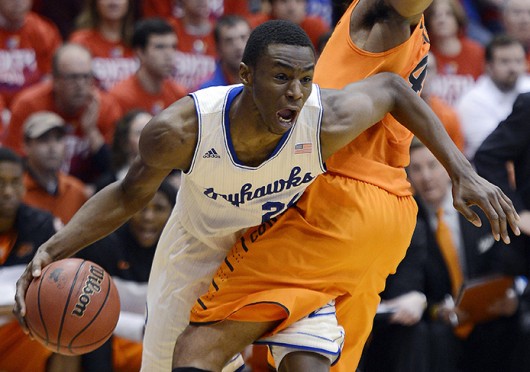
Kansas freshman guard Andrew Wiggins (22) drives to the basket during a game against Oklahoma State Jan. 18 at Allen Fieldhouse. Kansas won, 80-78.
Courtesy of MCT
A popular trend in men’s college basketball today is star freshmen, and along with them comes the hope their potential can bring a team to an elite playing level.
Ever since NBA commissioner David Stern enforced “Article X” in 2005, stating that any player entering the NBA draft must be, “At least 19 years of age during the calendar year in which the Draft is held, and with respect to a player who is not an international player, at least one NBA Season has elapsed since the player’s graduation from high school,” the way of the game has changed.
With many “one and dones” becoming stars in the NBA, such as Kevin Durant, Kevin Love, Kyrie Irving, Chris Bosh, Anthony Davis and Derrick Rose, many schools have started to look at freshmen as the key to winning, leaving behind the long-standing idea that experience is the most important key to winning a title.
However, especially recently, the top high school recruits have not brought success to their college team of choice. In fact, dating back to the year the rule became enforced, not one Rivals No. 1 overall high school recruit has won a national championship for his college team. The closest a player has come to reaching this status was former Ohio State center Greg Oden, who led the Buckeyes to the championship against Florida in 2007, only to lose to a team that returned all five starters from the year before.
Kentucky coach John Calipari has become the unofficial poster boy for recruiting “one and done” players. Since 2009, Calipari and Kentucky have recruited nine Rivals top-five high school prospects for their respective year, more than any other school. This method worked like a charm in 2011, as the team won a national title with three top-five recruits, but the following year, the Wildcats failed to reach the NCAA tournament with the No. 2 overall recruit.
While Kentucky has been taking this new idea head on, OSU and its coach, Thad Matta, have refrained from taking such an approach. The Buckeyes’ current starting five consists of two seniors and three juniors and at one point the team was ranked as high as No. 3 in the country.
However, things have taken a turn as of late and the Buckeyes have lost four games in a row and could soon drop out of the top 25, leading many to question Matta and his decision to not target the top incoming freshmen year in and year out and instead to build off of experience.
OSU’s situation might deter others from this approach, but three of the AP’s top five teams (Michigan State, Villanova and Wichita State) all have programs built around experienced upperclassmen.
Another telling stat is that of the previous seven top overall incoming freshmen, just two, Kentucky’s John Wall and Kansas’ Josh Selby, have made it to the Elite 8 in the NCAA tournament. Duke’s Austin Rivers, UCLA’s Shabazz Muhammad and OSU’s BJ Mullens lost in the first round of the tournament, while Kansas State’s Michael Beasley led Kansas State to the round of 32 teams.
This year has been no different. In fact, the top freshmen have been in the spotlight even more so than previous years. Top recruit Andrew Wiggins, guard for Kansas, has led the Jayhawks to a 14-4 overall record. Though he has shown glimpses of his elite potential, the most hyped high school basketball recruit since LeBron James has not been a crucial part of Kansas’ success. In fact, it could be argued that Wiggins’ classmate, center Joel Embiid, has played better, and Rivals had him listed at 25.
I’m not trying to say recruiting “one and dones” is a bad method to win in college basketball, because obviously, teams accrue wins using the method. However, I believe experience is still the best way to win it all. Freshmen are a great way to instantly add life to a team like OSU, who seem to lack energy on the court, but if the ultimate goal is to win a championship, which it should be for every team, experience is the way to go.
Matta and the Buckeyes do have a highly-touted recruiting class for next year with two Rivals top 25 recruits in guard D’Angelo Russell and forward Keita Bates-Diop, but the Buckeyes are also expected to return a majority of its current players. The new energy brought by next year’s freshmen combined with the experience of the returning players should easily spell success for OSU next year, or at least the idea behind it should.


